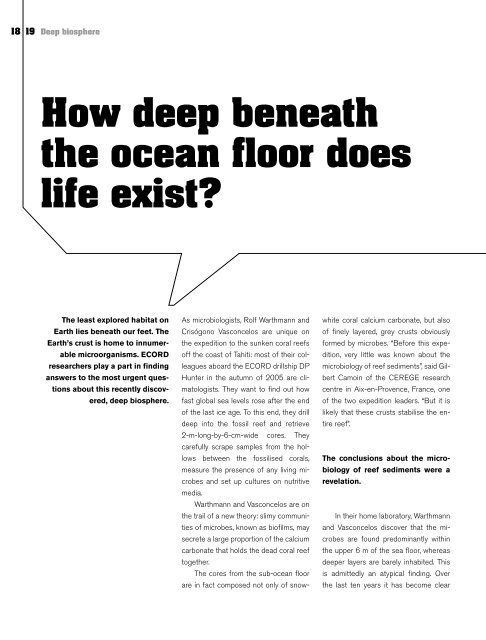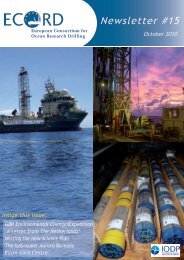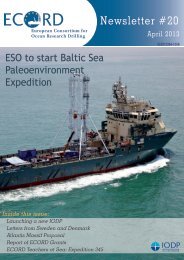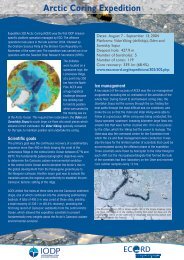printable version - European Consortium for Ocean Research Drilling
printable version - European Consortium for Ocean Research Drilling
printable version - European Consortium for Ocean Research Drilling
- No tags were found...
You also want an ePaper? Increase the reach of your titles
YUMPU automatically turns print PDFs into web optimized ePapers that Google loves.
18 19 Deep biosphereHow deep beneaththe ocean floor doeslife exist?The least explored habitat onEarth lies beneath our feet. TheEarth’s crust is home to innumerablemicroorganisms. ECORDresearchers play a part in findinganswers to the most urgent questionsabout this recently discovered,deep biosphere.As microbiologists, Rolf Warthmann andCrisógono Vasconcelos are unique onthe expedition to the sunken coral reefsoff the coast of Tahiti: most of their colleaguesaboard the ECORD drillship DPHunter in the autumn of 2005 are climatologists.They want to find out howfast global sea levels rose after the endof the last ice age. To this end, they drilldeep into the fossil reef and retrieve2-m-long-by-6-cm-wide cores. Theycarefully scrape samples from the hollowsbetween the fossilised corals,measure the presence of any living microbesand set up cultures on nutritivemedia.Warthmann and Vasconcelos are onthe trail of a new theory: slimy communitiesof microbes, known as biofilms, maysecrete a large proportion of the calciumcarbonate that holds the dead coral reeftogether.The cores from the sub-ocean floorare in fact composed not only of snow-white coral calcium carbonate, but alsoof finely layered, grey crusts obviously<strong>for</strong>med by microbes. “Be<strong>for</strong>e this expedition,very little was known about themicrobiology of reef sediments”, said GilbertCamoin of the CEREGE researchcentre in Aix-en-Provence, France, oneof the two expedition leaders. “But it islikely that these crusts stabilise the entirereef”.The conclusions about the microbiologyof reef sediments were arevelation.In their home laboratory, Warthmannand Vasconcelos discover that the microbesare found predominantly withinthe upper 6 m of the sea floor, whereasdeeper layers are barely inhabited. Thisis admittedly an atypical finding. Overthe last ten years it has become clearthat the Earth’s crust is inhabited by innumerablemicrobes. According to estimates,more prokaryotic organisms livewithin this deep biosphere than on thesurface.All ECORD expeditions followingthe drilling operations off Tahiti will nowinclude microbiologists. <strong>Drilling</strong> into thesub-ocean floor offers a unique opportunityto closely study this still largelyunknown habitat, which is why researchinto the deep biosphere is one of thethree main goals of the IODP’s theme‘The deep biosphere and the subseafloorocean’.In soft sediments, microorganismshave been identified down to depths ofmore than 1 km. “It is a little shockingthat the deep biosphere is somehowan exotic habitat although it harboursa large proportion of life on Earth”, saidBo Barker Jørgensen, director of theMax Planck Institute <strong>for</strong> Marine Biologyin Bremen, Germany. The single-celledorganisms not only decompose the biomasswithin the deep-sea mud, they alsodigest iron contained in the basalt rockbeneath, as well as the hydrocarbonsof subseafloor oilfields. Some microbesneed nothing more than rocks, waterand radioactivity to survive. One of thegreatest puzzles of the deep biosphere,which the IODP expeditions aim to solve,is the high density of microbial populationsin the depths.Unseen survival strategies of theocean dwellersBo Barker Jørgensen has calculatedthat the microbes in the sub-ocean floorshould theoretically only be able to divideevery thousand years. “Previously,we were unable to explain how theycould survive with so few nutrients”, saidthe researcher. Amongst these hardysurvivors, microbiologists hope to findnew organisms of use in biotechnology,the clean up of contaminated soils, miningor oil production.







